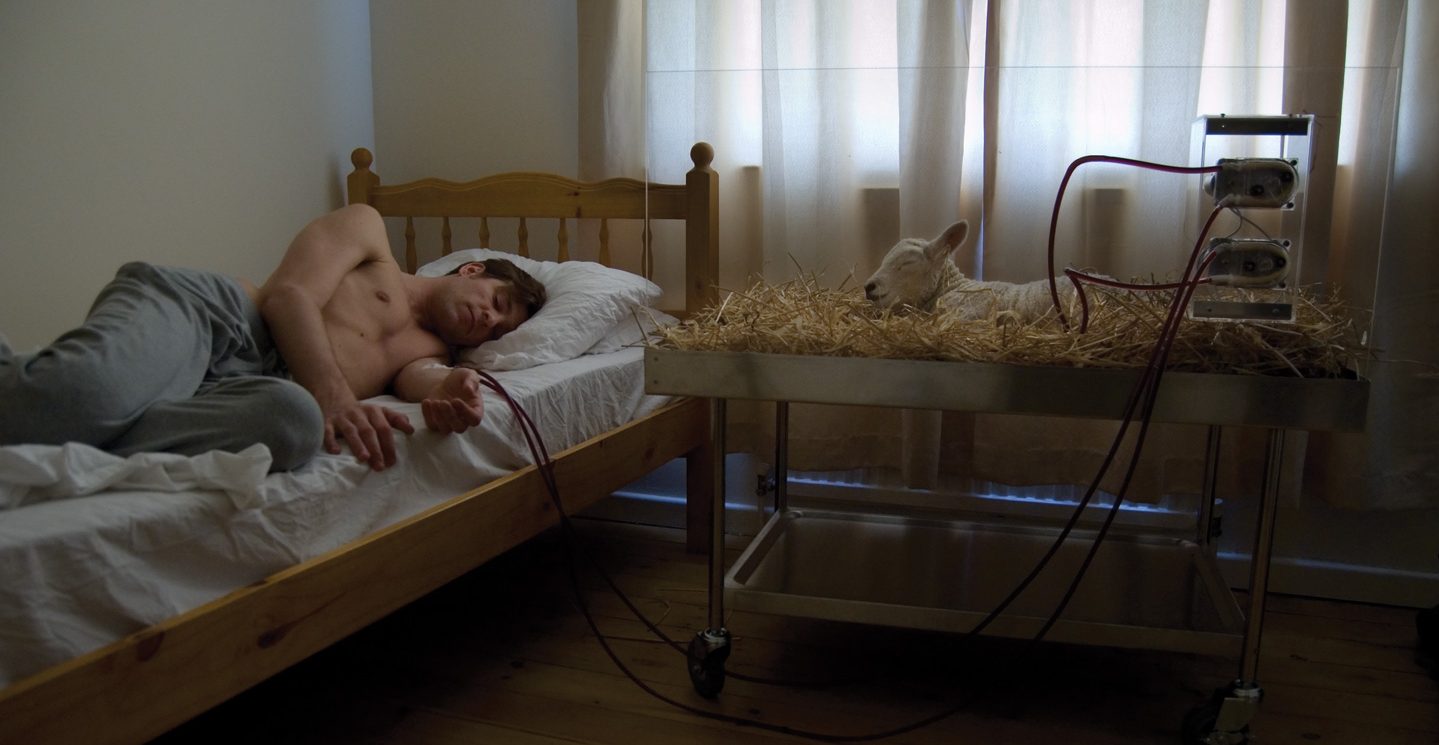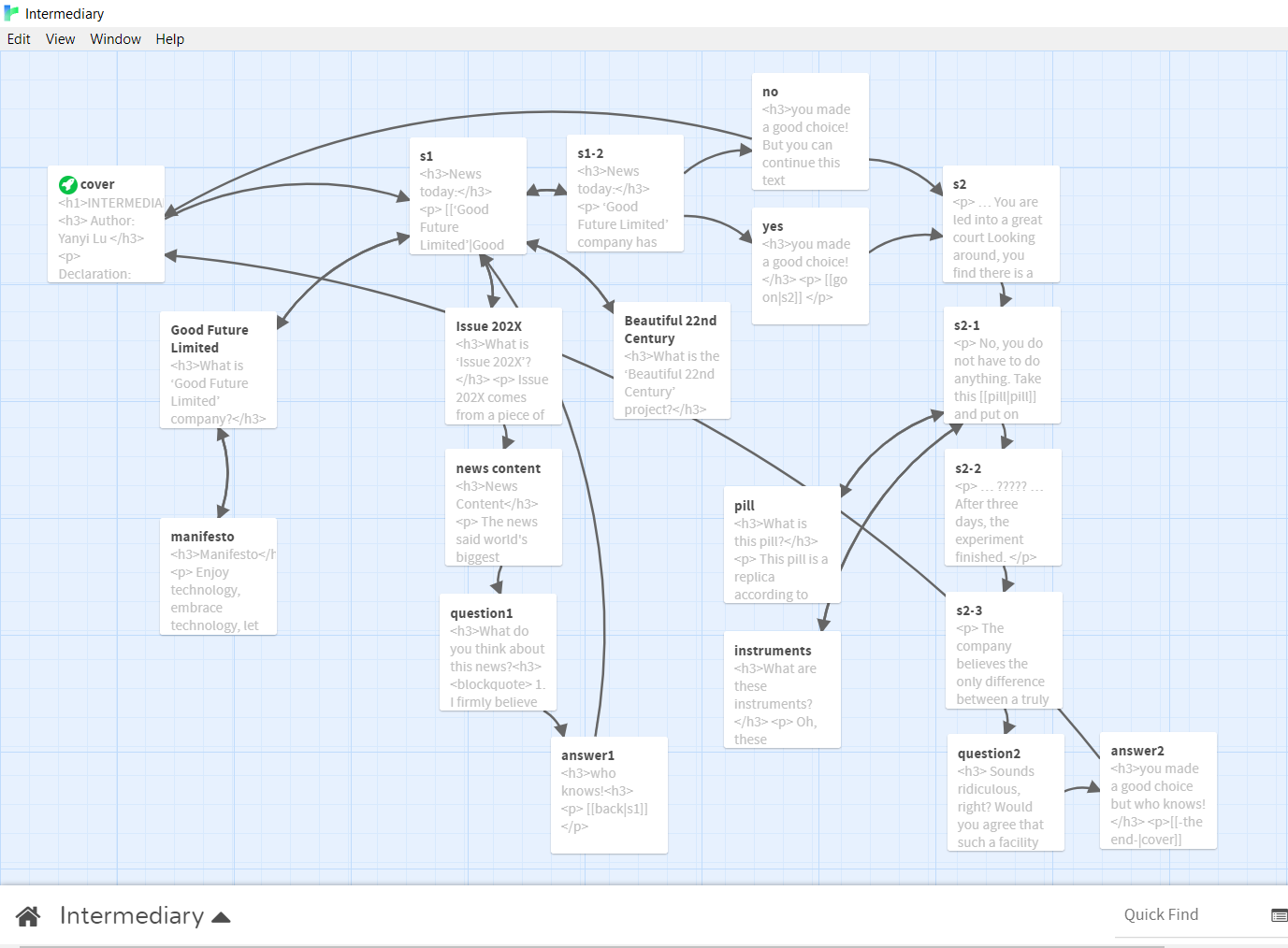Intermediary: A Utopian Cure
Abstract
This project originates from an interesting phenomenon that more and more people express their pursuit and worship of naturalism but criticism and suspicion of industrialization. Based on this, this research project deeply discusses the conflict traditional animal and plant medicine faces in medical ethics and environmental protection. In view of the phenomenon that the same-effect substitute of wild medicine is hardly recognized, I make an interactive fiction to discuss the relationship between man and nature, hoping to find the balance point of this conflict and arouse people's critical thinking of naturalism through this utopian fiction.
Click to play: https://yanyi.itch.io/intermediary-a-utopian-cure
produced by: Yanyi Lu
Methodology
1. Multispecies storytelling
2. Critical technical practice
3. Autoethnography: Part of the research is based on my own life experience and narration
4. I started this research project from a wide topic. Then, I narrowed it down and mapped the context to find the gap and research opportunity. After that, I selected a representative species to tell the whole research story in my artefact, an interactive fiction.
Background Mapping
This project was originated from the discussion of an interesting phenomenon that modern people are more willing to pursue natural lifestyle and buy organic stuff. Some people have a bad impression on mass industrial production and think products with the tags like homemade, free-range and natural style planting are more nutritious, environmentally friendly and non-pollution.
However, the truth might be on the opposite way. Organic lettuces which are free of herbicides and pesticides must be pulled by hand to kill insects. Growing organic tomatoes uses 10 times more land and nearly twice as much energy as growing regular tomatoes, which means more carbon emissions. Currently, there is no data to suggest that organic produce must be safer or more nutritious.
Slightly different with choice of an organic or greenhouse food, the choice of wild or cultivated plant and animal medicine becomes a more serious, controversial, specific and complex question in medical field.
Contextual Review
Plant and animal medicinal materials is a complex system like a huge web linking many objects. It is not only a choice for organic/wild or mass production medicine but also entangle the technology, ethic, health, labor, culture and environment issues.
picture below: context visualization and positioning
In my observation, some people especially the older firmly believe the effect of animal and plant medicine on the ancient medical books. From an empirical point of view, we must admit there have been countless patients saved indeed by these medical material during thousands of years. I acknowledge some of them are effective and efficient. For example, Honeysuckle and artemisia annua. They respectively have marked effect on anti-bacterial and malaria.
However, I have always been skeptical of certain plant and animal medicines. Some have been shown in scientific experiments that they have low levels of active ingredients and actually little effect on the body. Some of them are exaggerated and boosted by drug vendors just based on vague and specious record in ancient books.
Besides these, some plant or animal treated as medicine might be because of the deep-rooted cultural superstitions. In public awareness of continuous symbol meaning, tiger is linked with physical strength, rhino with tonifying Yang (impotence cure) and pangolins' burring bio-behavior with mother’s fluent milk. I may call it as a placebo of cultural symbol.
Read and watch more about the examples mentioned above:
What's Driving Tigers Toward Extinction? https://www.youtube.com/watch?v=qhrT0v7QSvc
Enough with the Fake Rhino Horns https://blogs.scientificamerican.com/extinction-countdown/enough-with-the-fake-rhino-horns/
Traditional Chinese medicine and illegal wildlife trade http://podcasts.ox.ac.uk/traditional-chinese-medicine-and-illegal-wildlife-trade
Traditional Chinese Medical Authorities Are Unable to Stop the Booming Trade in Rare Animal Parts https://time.com/4578166/traditional-chinese-medicine-tcm-conservation-animals-tiger-pangolin/
Artwork Review:
picture1&2: Life support (Respiratory Dog & Dialysis Sheep) by Revital Cohen (2008) https://www.cohenvanbalen.com/work/life-support
picture3: Prospect resort by Sascha Pohflepp (2008) https://www.flickr.com/photos/saschapohflepp/2500513046
picture4: Tiger Penis Project by Kuang-Yi Ku http://www.tigerpenisproject.com/
Annotated Bibliography
“It is possible that many practitioners of TCM are not fully aware of the fact that the majority of animal medicinal preparations are obtained under uncontrolled or otherwise suspect circumstances…the extraction of the bile (whether from a bear or a snake) requires opening of the abdominal cavity. This is a surgical procedure, which should only be performed by a registered veterinary surgeon…There is doubt whether these medico-legal and humanitarian considerations are being fulfilled in those establishments.” - Still, J., 2003.
Note1: We know that plants and animals picked or hunted in the wild are likely to carry germs or hazardous substances. However, even if some animal and plant medicines are legally allowed to be farmed on a large scale, there are still some ethical and safety concerns, for example, whether the acquisition of medicinal materials is humane, whether the breeding environment is sanitary, whether the transport is pollution-free and whether there is quality control such as heavy metal testing.
----------------------------------------------------------------------------------------------------------------------------------------------------
“It is our responsibility to protect threatened animals, however, the demand for traditional medicine is also an undeniable fact. We carry on this study through the identification for threatened animals combined with seeking for their substitutes. Taking some animals of Bovidae and Cervidae for examples, we preliminarily deem that the strategy based on DNA Barcoding and bio-response can establish a feasible balance between the protection of threatened animals and the development of traditional medicine. Because comparing with wild animal resources, the fertile animals with similar bioactivities can be propagated at large scales, and many of them are unused animal tissues from animals farmed for their meat (e.g., horn).” – Yan et al., 2013
Note2: There are many alternatives that have similar effects, for example, replacing the horns of endangered rhinos with the horns of gazelles. However, there is still a problem that people seem not trusting substitutes and firmly believing the natural wild one is the most effective.
----------------------------------------------------------------------------------------------------------------------------------------------------
“…the claims helped to turn the fungus into a valuable commodity, as did subsequent rumors in 2003 that it could help ward off SARS. Demand surged and collecting and selling the weird parasite became truly profitable…People mostly take it as a generic immune booster, or to treat a growing list of conditions, including cancer. Its antitumor properties have never been tested in a clinical trial, but researchers have isolated pharmacological compounds from the organism…In many rural areas, it is the single most important source of cash income. People have rearranged their lives around the harvest. Some have fought violently over access to fungus zones. Certain schools schedule vacations so that students can go collecting.” - Yong, 2018.
Note3: When I was a child, I suffered from a disease. After using some western medicine without great effect, my doctor advised me to use this plant medicine. My parents bought some at great cost. I know many patients with the same disease say it does work, but it does not seem to improve much when I take it. In Chinese pharmacopoeia, cordyceps sinensis is only recorded to have some effect on the lungs and kidneys. Because of rumors and hype, prices have been going up crazily. Vegetation destruction occurs in the original area due to excessive excavation. I also have a mixed feeling to realize that local people have made it an important or even only source of income. This situation made me think about how to balance hopeless patient’s need for medicine, the ruined environment and local people's lives.
Affirmative Intervention
Based on these researches, I hope I can find a balance point to make affirmative intervention in this complex system.
Equation:
Wild medicine = wild DNA + wild growth environment
Cultivated medicine = wild DNA + lab growth environment
People believe the wild one has some mysterious power (also called Reiki: the invisible energy flow between man and nature) that the cultivated one lose. I compare these two and think whether the wild natural environment is the secret of Reiki and the herb plays a role of middleman to transfer this power of cure from nature to human body.
Therefore, I created a facility in my fiction to ease the conflict between strong demand of rare wild plant medicine and environmental issue based on this middleman theory. The software I use is twine, a tool for writing web interactive fiction.
pictures below are the making process screenshot (pic1: storyboard; pic2: storyline script; pic3: CSS)
Future Development
Due to the restriction of COVID-19, I choose to make an interactive fiction as my final artefact. I would possibly make a prototype of the facility mentioned in the fiction in the future.
Conclusion
I hope players can rethink the relationship between man and nature through this project. Meanwhile, I also try to attract people’ attention to the conflict between medical ethics and environmental ethics in the field of traditional medicine, and critically reflect on the advantages and disadvantages of naturalization and industrialization.
Full Reference
Still, J., 2003. Use of animal products in traditional Chinese medicine: environmental impact and health hazards. Complementary Therapies in Medicine, 11(2), pp.118–122.
Yan D, Luo JY, Han YM, Peng C, Dong XP, et al., 2013. Forensic DNA Barcoding and Bio-Response Studies of Animal Horn Products Used in Traditional Medicine. PLoS ONE 8(2): e55854. doi: 10.1371/journal.pone.0055854
Goetzke, B., Nitzko, S. & Spiller, A., 2014. Consumption of organic and functional food. A matter of well-being and health? Appetite, 77, pp.94–103.
Landström, E., Hursti, U.-K.K. & Magnusson, M., 2009. "Functional foods compensate for an unhealthy lifestyle". Some Swedish consumers' impressions and perceived need of functional foods. Appetite, 53(1), pp.34–43.
Schimelpfenig, R., 2017. The Drama of the Anthropocene: Can Deep Ecology, Romanticism, and Renaissance Science Rebalance Nature and Culture? American Journal of Economics and Sociology, 76(4), pp.821–1081.
Yong, E., 2018. The World’s Most Valuable Parasite Is in Trouble Available at: https://www.theatlantic.com/science/archive/2018/10/tibetan-caterpillar-fungus-trouble/573607/ [access on: 13 Feb 2020].
Grayson, M., 2011. Traditional Asian medicine. Nature, 480(7378), p.S81.
Tian, P., 2011 Where West meets East. Nature, 480, p.S84.
Xu, Z, 2011. One step at a time. Nature, 480, p.S90-92. doi:10.1038/nature10977.
Graham-rowe, D., 2011. Endangered and in demand. Nature, 480, p.S101-103.
Zhilyaev, A., 2016. Factories of Resurrection: Interview with Anton Vidokle. https://www.e-flux.com/journal/71/60539/factories-of-resurrection-interview-with-anton-vidokle/ [access on: 19 April 2020]
National Geographic, 2018. What's Driving Tigers Toward Extinction? https://www.youtube.com/watch?v=qhrT0v7QSvc [access on: 25 Feb 2020]
Platt, J., 2019. Enough with the Fake Rhino Horns https://blogs.scientificamerican.com/extinction-countdown/enough-with-the-fake-rhino-horns/ [access on: 17 March 2020]
Huang, L., 2017. Traditional Chinese medicine and illegal wildlife trade http://podcasts.ox.ac.uk/traditional-chinese-medicine-and-illegal-wildlife-trade [access on: 17 March 2020]
Campbell, C. & La, M., 2016. Traditional Chinese Medical Authorities Are Unable to Stop the Booming Trade in Rare Animal Parts https://time.com/4578166/traditional-chinese-medicine-tcm-conservation-animals-tiger-pangolin/ [access on: 20 March 2020]
Cohen, R., 2008. Life support (Respiratory Dog & Dialysis Sheep) https://www.cohenvanbalen.com/work/life-support [access on: 02 April 2020]
Pohflepp, S., 2008. Prospect resort https://www.flickr.com/photos/saschapohflepp/2500513046 [access on: 02 April 2020]
Ku, K., Tiger Penis Project. http://www.tigerpenisproject.com/ [access on: 04 May 2020]






































































